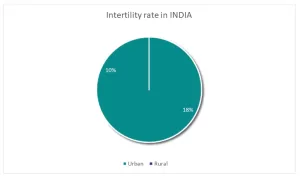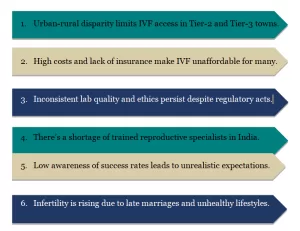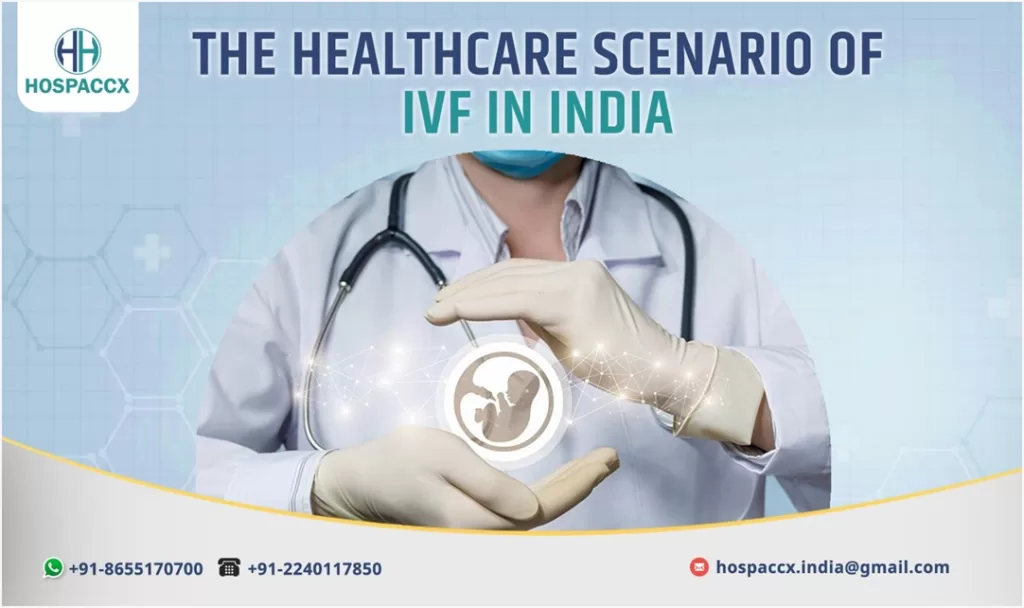INTRODUCTION
Infertility, once a taboo subject, is now being addressed more openly in India, thanks to medical advancements and rising awareness. In-vitro fertilization (IVF), a key component of Assisted Reproductive Technology (ART), has emerged as a beacon of hope for millions of couples facing infertility. While India is becoming a global hub for fertility treatments, significant disparities in access, affordability, and awareness continue to persist.
DEMOGRAPHIC PROFILE
| Estimated Population | 125 million |
| Infertility Prevalence | ~10–15% of married couples |
| ART Clinics
(Registered under ART Act, 2021) |
~1,800+ clinics |
| Average IVF Success Rate (per cycle) | ₹1.2–2.5 lakhs (avg.) |
| Cost per IVF Cycle | 32 per 1,000 live births |
| IVF Market Growth Rate (CAGR) | ~15–20% (2022–2027 forecast) |
HOW DOES INDIA COMPARE GLOBALLY?
| Indicator | India | Global Average |
| IVF Success Rate (Women <35) | ~45% | ~50% |
| ART Clinics per million | <5 | >15 (Developed countries) |
| IVF Affordability | High out-of-pocket | Insurance coverage in many countries |
INFERTILITY BURDEN IN URBAN VS RURAL INDIA

Inference:Urban India has a higher prevalence of infertility due to delayed childbearing, work stress, obesity, pollution, smoking, and hormonal imbalances (like PCOS).
Rural India, while having a slightly lower infertility rate, suffers from lack of access to fertility services and higher rates of infections (like STIs and tuberculosis of the reproductive tract) that go untreated.
CURRENT CHALLENGES IN IVF CARE

💡WHY INVEST IN IVF INFRASTRUCTURE & POLICY REFORM?
🔬 Support Rising Infertility Burden: Increasing infertility rates demand broader access to scientifically backed solutions.
🏥 Build Inclusive Fertility Centres: Establish standardized ART clinics in underserved regions with advanced labs and ethical oversight.
👩⚕️ Train Human Resources: Develop reproductive specialists and embryologists through certified courses and mentorship programs.
🧠 Psychosocial Support: Integrate mental health support and counselling services into fertility treatment.
💰 Improve Affordability: Introduce insurance coverage, government support, and subsidies for economically weaker sections.
📊 Enable Data Transparency: Strengthen ART Registry for outcome tracking and policy planning.
🌍 Global Medical Tourism Potential: Promote India as a quality yet affordable IVF destination with regulatory compliance.
GOVERNMENT INITIATIVES SUPPORTING IVF
| Initiative | Key Features |
| ART Regulation Act (2021) | Mandates registration, regulation, and ethical practices in ART clinics. |
| Surrogacy Regulation Act (2021) | Allows altruistic surrogacy; bans commercial surrogacy. |
| IRDAI Advisory (2022) | Encouraged insurers to offer fertility treatment coverage, though not mandated. |
| National ART Registry | Collects data from clinics to ensure quality and accountability. |
| Ayushman Bharat (Prospective Inclusion) | Discussions underway to include ART under public health insurance schemes. |
IS THERE A NEED FOR SPECIALIZED IVF HOSPITALS?
Absolutely – Here’s Why:

CONCLUSION
India stands at the cusp of an IVF revolution. The demand is soaring, and medical capabilities are advancing—but without equitable access, financial protection, and regulatory enforcement, this revolution could remain confined to urban elites. By investing in dedicated IVF hospitals, ethical oversight, and supportive policies, India can ensure that the dream of parenthood becomes a reality for all—regardless of geography or economic status.
Sources:
https://www.jri.ir/documents/fullpaper/en/140200.pdf?utm_source=chatgpt.com
https://www.who.int/news/item/04-04-2023-1-in-6-people-globally-affected-by-infertility/
Related Team Members




















